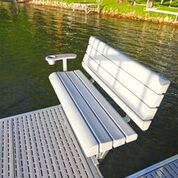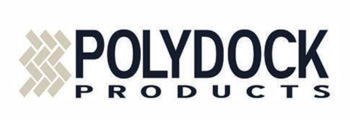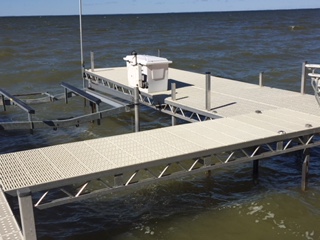
May 28, 2020
Is Your Pier Missing a Dock Storage Box?
Is a Dock Storage Box on your summer shopping list? How many times do you walk to your pier, only to kick yourself because you wish you had a storage box? Do you always forget something? Every time you set foot on your dock, do you think of all the equipment you could store in it? Where do you store the life preservers? Wouldn’t a dock storage box be convenient?
What Makes A Great Storage Box?
Unsure of what to look for in a storage or dock box? Are you afraid to purchase one because you don’t know enough about them? Read on to find helpful info about storage boxes. They will make life much easier for you.
Does the Storage Box Have Tight Fits?
Water Laser Cutting Technology, used on the best dock storage boxes, ensures the best fit. This process offers a consistent, precision cut for all the various pieces. This precision makes for a superior fit. Precision cuts and quality hinges fit together better. The box is less likely to suffer from leaks or damage.
Additionally, these dock storage boxes constructed from fiberglass provide a far superior product.
What’s The Alternative?
The alternative, polyethylene (plastic) storage boxes, fade, discolor, and warp in sunlight. As a result, this depreciates its usage and aesthetic value.
Fiberglass dock storage boxes also come with a gel-coat finish to add an extra layer of protection. Like polyethylene dock boxes, the gel-coat finish will oxidize in sunlight. So what’s the difference then? The difference is, you can buff and wax the oxidation off of the box to keep it looking brand new, year after year.
Buffing and waxing increase the durability of the box in the form of scrape and cut resistance. You can buff and wax any imperfections with a rubbing compound and watch them disappear. The process is like cleaning the hull of a boat on a smaller scale.
Do Polyethlene Dock Storage Boxes Have Gel-Coating?
Polyethylene dock storage boxes do not have a gel-coat finish. Once the sun damages the plastic material, it’s impossible to restore the surface to a like-new finish again.
The failure of the polyethylene storage boxes to withstand the sun will cause you to consider buying a new dock box. This type of failure will happen much sooner with a Polyethylene box than if you had chosen a fiberglass dock box initially.
Choose quality first to save time and money.
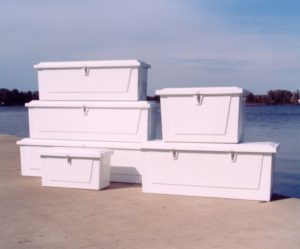
Assorted Dock storage Box sizes
Dock storage boxes come in many sizes including:
98″ x 22″ x 24.5″ H 85″ x 22″ x 24.5″
72″ x 26.5″ x 27.5″ 74″ x 38″ x 36″
71″ x 22″ x 24.5″ 33″ x 24″ x 18″
44.5″ x 26.5″ x 27.5″ 39.5″ x 19.75″ x 21.5″
Triangular and Low profile versions are also avaiable. Call for more information.
Not enough room to mount a dock box on your dock?
PWS has alternatives including, side mounts, for the boxes.
NEW – this year!
This year PWS has another alternative that was not available in the past. Talk to Jerry about trading your dock for the new 3-Season Pier, which we are now offering.
This new steel dock can handle storms better due to it’s higher weight and the “open” decking we use. Combining these two features makes it the heaviest pier on Green Bay. It has survived installations on Lake Michigan also.
An additional feature is the 4′ x 10′ “L,” which is standard on the 3-Season dock. This allows 16 sq feet more than lesser docks. It makes it easier to mount a dock box, enter a boat lift, and entertain your friends.
Tell Your Friends & Family
Have friends or neighbors you believe should see this article? Email them this link – and Thank you!
Don’t Forget – Considering rip-rap for your shoreline? PWS is the place to contact!
Where is Pier & Waterfront Solutions?
Located at 7325 St. Hwy 57, it’s 3 miles south of Sturgeon Bay, and 1 mile past the intersection of Cty MM (heading north). Look on the right side, one mile north, at the next intersection (Idlewild Road and Hwy 57).
ARE WE OPEN?
During this time of uncertainty, Pier & Waterfront Solutions is staying “open.” We have implemented measures to ensure the safety of our employees and visitors. At the same time, we are working to maintain the trusted service that you have come to expect.
We are implementing these precautionary measures:
1. Conducting as much business as possible by email, text, or phone.
2. Site visits will continue but with limited in-person meetings. When in-person contacts are necessary, we will follow “social distancing” guidelines.
3. Our display yard is always open for you to examine at your leisure. All displays have a numbered, red tag on them. If you want more information or pricing, please reference that number.
Is there More?
4. Some employees will be working remotely, but they are always available by phone.
5. Any employee with symptoms or illness is sent home.
6. We continue to provide estimates and invoices by email to make the process paperless.
7. Crew starting times are being staggered to limit social interactions.
8. We keep the same crews together to limit cross interactions.
With these measures, we hope everyone will stay safe, and we will be back to normal operations soon.
What can you do to help us?
1. Please conduct as much business as possible via emails, messaging, and emails. This step protects everyone involved.
2. When you see our crews installing equipment, please practice “social distancing.”
Thank you for allowing us to work with you.
So – YES – ARE WE OPEN?
Please call, message, or email us with any questions.
Let’s all stay safe!
Contact:
Jerry @ (920) 493-4404 or Jerry@wisconsinpws.com – Commercial work & new/used Sales.
Dave @ (920) 905-2588 or Dave@wisconsinpws.com – Erosion control & shoreline work.
Jerry @ (920) 493-4404 or Jerry@wisconsinpws.com – Scheduling & Service work
May 26, 2020
10 Best Boat Docking tips
Docking a boat or putting it into a boat lift is not the favorite activity for any boater. Until you feel confident about what you are doing, it can be down-right terrifying. It was so easy to go out. – why can’t it be just as simple to come back in?
Follow the best boat docking tips shown here and it will make it easier for any boater.
- Always put safety first. Check the surrounding area before approaching a dock. Kids love to swim under the dock to greet you.
- VERY IMPORTANT – How fast are you going? Are the waves pushing you too fast? Are you willing to hit the dock or boat lift at that speed?
- Remember – Slow speeds will always give you more time to correct your course. Slower speeds also cause less damage. On the flip side, it is harder to control the boat at slower speeds.
Follow the next steps for greater control:
- Always turn the wheel BEFORE applying any power – not during or after. This is very important for a single-engine boat.
Note – Twin inboards? Keep your hands off the wheel with twin inboards. If you do turn the wheel, the boat may take an unexpected path when you try to use the engines.
- Apply short bursts instead of steady power to the engine. You won’t build up a lot of momentum, and you will have better control of the boat. Speed and momentum are the opposite of control.
- Always stay under power. Without power, you can not control the direction of the boat. Keep the engine on so you can maneuver as necessary.
- Secure all ropes and make sure they are not wrapped around anyone’s hands or feet.
- Always communicate with passengers as you approach the dock. Managing your crew or guests before and during docking is important to make docking safer.
- Always reduce your windage in heavy winds. Particularly in a small boat.
- Don’t worry about stopping and doing it over again. If you see a problem, it’s better to reverse the motor than hit something. On your next pass, it may be better – come back for another try.
Tell Your Friends & Family
Have friends or neighbors you believe should see this article? Email them this link – and Thank you!
Where is Pier & Waterfront Solutions?
Located at 7325 St. Hwy 57, it’s 3 miles south of Sturgeon Bay, and 1 mile past the intersection of Cty MM (heading north). Look on the right side, one mile north at the next intersection (Idlewild Road and Hwy 57).
We look forward to talking to you.
ARE WE OPEN?
During this time of uncertainty, Pier & Waterfront Solutions is staying “open.” We have implemented measures to ensure the safety of our employees and visitors. At the same time, we are working to maintain the trusted service that you have come to expect.
We are implementing these precautionary measures:
1. Conducting as much business as possible by email, text, or phone.
2. Site visits will continue but with limited in-person meetings. When in-person contacts are necessary, we will follow “social distancing” guidelines.
3. Our display yard is always open for you to examine at your leisure. All displays have a numbered, red tag on them. If you want more information or pricing, please reference that number.
Is there More?
4. Some employees will be working remotely, but they are always available by phone.
5. Any employee with symptoms or illness is sent home.
6. We continue to provide estimates and invoices by email to make the process paperless.
7. Crew starting times are being staggered to limit social interactions.
8. We keep the same crews together to limit cross interactions.
With these measures, we hope everyone will stay safe, and we will be back to normal operations soon.
What can you do to help us?
1. Please conduct as much business as possible via emails, messaging, and emails. This step protects everyone involved.
2. When you see our crews installing equipment, please practice “social distancing.”
Thank you for allowing us to work with you.
So – YES – ARE WE OPEN?
Please call, message, or email us with any questions.
Let’s all stay safe!
Contact:
Jerry @ (920) 493-4404 or Jerry@wisconsinpws.com – Commercial work & new/used Sales.
Dave @ (920) 905-2588 or Dave@wisconsinpws.com – Erosion control & shoreline work.
Jerry @ (920) 493-4404 or Jerry@wisconsinpws.com – Scheduling & Service work
May 19, 2020
The Best Boat Dock Decking in Door County
Boat dock decking is no longer a simple piece of wood laid on other pieces of wood. There are many types of materials used on piers and boat docks today.
Today’s options include open-deck plastic, solid plastic boards, aluminum, wood, and various composites.
What’s the most popular decking used today, and why?
Today, wise shoppers choose plastic with the open-deck configuration.
Why?
It’s simple. The best type of decking is a plastic deck. Today’s plastic holds it’s original color (within 3%). It also keeps it’s shape better. Plastics need less maintenance than any of the other types of decking.
Plastic decking requires no staining or painting. The surface does not flake or wear-off, nor does it lose its color with exposure to the UV rays.
Open-decking helps resist the growth of mold and mildew far better than wood or even another plastic deck. Plastic stays cool in the summer, repels rain and dries quickly. About 90% of the moisture runs off immediately while the rest simply evaporates.
What about other types of plastic boat dock decking?
If you are referring to the wood and resin-impregnated boards, over time, the wood fibers swell. The moisture can attract mold and mildew.
How about recycled plastic boards with no fiber in it?
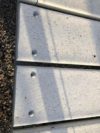
Typical Plank decking
The recycled boards come with their unique problems.
If stored in shaded areas, HDPE plastic boards cannot escape the mold/mildew cycle. See how the mold/mildew cycle develops HERE.
What’s the most important thing about decking?
Recycled decking is an extruded board. That means, when cresting waves hit the bottom of the dock, there is no release for the energy waves produce. The bolted-down boards keep the decking from washing away. But this creates a virtual “solid” surface for the wave’s energy to push against. The frame structure must take all the energy from the wave.
How can you prove this?
Look at a dock that flipped over during a storm. You will notice that the legs bent in the direction that the storm originated.
Solid boards with a 1/2″ gap every 6″ does not relieve the pressure from the waves.
The result is the upward pressure from the waves lifted the pier high enough for it to move sideways. The legs were no longer vertical. They came down at an angle, and the legs bent. The continuing pressure from the waves then pushed the dock over.
Plastic is plastic – isn’t it?
Yes, they are all oil derivatives. But, there are many types of plastic made today. Some are super hard and act as “bearing surfaces,” while others are very pliable.
In general, plastics will outlive us. The shape and surface area of the plastic makes a big difference when it comes to decking.
How do you relieve the upward energy?
The only way to relieve the pressure on the boat dock decking is to provide enough open areas for the wave energy to pass through. 42% open area is the standard today.
At this percentage, almost one-half of the wave energy passes through the decking. The wave is less likely to lift the dock. Yet the decking is strong enough to walk on.
If you combine the most massive steel frame in Door County along with an open deck,
you get the PWS 3-Season Pier.
Don’t Forget – Considering rip-rap for your shoreline? PWS is the place to contact!
Where is Pier & Waterfront Solutions?
Located at 7325 St. Hwy 57, it’s 3 miles south of Sturgeon Bay, and 1 mile past the intersection of Cty MM (heading north). Look on the right side, one mile north, at the next intersection (Idlewild Road and Hwy 57).
ARE WE OPEN?
During this time of uncertainty, Pier & Waterfront Solutions is staying “open.” We have implemented measures to ensure the safety of our employees and visitors. At the same time, we are working to maintain the trusted service that you have come to expect.
We are implementing these precautionary measures:
1. Conducting as much business as possible by email, text, or phone.
2. Site visits will continue but with limited in-person meetings. When in-person contacts are necessary, we will follow “social distancing” guidelines.
3. Our display yard is always open for you to examine at your leisure. All displays have a numbered, red tag on them. If you want more information or pricing, please reference that number.
4. Some employees are working remotely, but they are always available by phone.
5. Any employee exhibiting symptoms or illness is sent home.
6. We continue to provide estimates and invoices by email to make the process paperless and faster.
7. Crew starting times are being staggered to limit social interactions.
8. We keep the same crews together to limit cross interactions.
With these measures, we hope everyone will stay safe, and we will be back to normal operations soon.
What can YOU do to help us?
1. Please conduct as much business as possible via emails, messaging, and emails. This step protects everyone involved.
2. When you see our crews installing equipment, please practice “social distancing.”
So, YES – WE ARE OPEN!
Thank you for allowing us to work with you.
Please call, message, or email us with any questions.
Let’s all stay safe!
May 14, 2020
USED BOAT LIFT GUIDE – Part 2
Are you thinking about buying a used boat lift? This two-part series concludes with four additional items to check. Upon completion, we will have guided you through eight problems to look for when buying a used boat lift.
See Part 1 for the first four checks.
Here’s the second list of things to check:
- Does the cable wind smoothly and correctly on the winch?
- Do the cables have rust on them? Does it use galvanized or stainless steel cables?
- Are there any “kinks” or other visible problems on the cable?
- How often were they lubricated, and with what lubricant?
Does the cable wind smoothly around the winch?
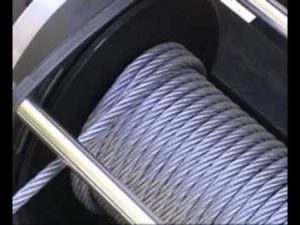
Properly wound Boat lift cable
If you look up inside the winch housing, if it has an enclosure, you will be able to see how the cables are winding. It should be a smooth pattern without any “crossed” cables. If the winch has no outer covering, you can readily see the pattern.
The wire cable has a “memory” to it. Once the cable gets crossed, it will tend to do it again the next time the cable rewinds.
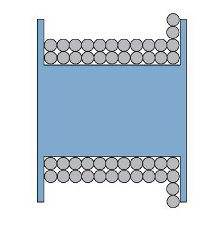
Typical Cable Stacking
If the cable is wrapping in layers, you will get a thunderous sound when the cable finally “falls off” the stack. This movement scrapes the galvanizing of the wire, and rust will form. The “shock” of dropping a 2,000# (or more) weight will also apply excessive stress on the cables.
Do the cables have rust on them?
Galvanized cables will rust over time. The movement of individual strands of the wire against each other cause rust. This movement occurs as they wrap around the winch and pulleys. There is no way to end this.
The only thing you can do is lubricate the cables. The lubrication reduces the friction between individual strands. Lubrication, in turn, lengthens the life of the cable. For more details click HERE.
Rust on the cable indicates that some galvanizing has worn off. Individual wire strands are compromised.
What about rust on a stainless steel cable?
Stainless steel does not rust, but it does pick up loose rust from the winch. Winches are plain steel with a painted surface. When the paint rubs off, the steel will rust and “bleed” onto the cable.
It’s much like a scratch on a car. The rust will run down the side of the vehicle.
The rust typically appears near the winch when the rack is in a lowered position. Under these circumstances, it’s ok. Try to lubricate the cables every year to slow this down.
Are there any visible signs of problems with the cables?
We recommend you lower the “rack” down, but DO NOT allow “slack” to form in the cables. Slack in the cables will allow the windings at the winch to unwind and cross over each other.
It’s much like a fishing reel getting snagged when there is no tension on the line.
Are the cables on the used boat lift adjusted equally?
If three of the four corner cables appear “tight,” the cables will need re-adjustment to re-distribute the weight equally.
Even proper positioning of the boat is essential.
If it takes excessive weight to lower the rack, look at the pulleys in each corner. Are they free to move? Is there sand, seaweed, or reeds packed around the pulleys? Remove any debris to free up the rack.
If any pulleys resist rotation, the rack will not lower smoothly. You must find out why the rack is not moving.
Note: In the case of jet ski lifts, the weight of the rack may not be enough to cause the rack to lower by itself. Have someone lean of the back of the lift to assist the rack in lowering. Still, hanging up? Check all the pulleys as above.
Check the fittings on the ends of the cable. Has rust formed on the fittings, or are there broken strands?
Caution– watch out for the ends of the cables. It’s a painful reminder of exposed strands.
Examine the entire length of the cable for frays (broken strands).
Caution – DO NOT run your hand up and down the cable without leather gloves. Broken strands on the cable will cause painful cuts on an unprotected hand. Ordinary cloth gloves will not protect your hand.
Are there any “kinks” or other visible problems?
Here are the warning signs of defects in your cables.

Frayed Boat Lift Cable

Broken cable strands
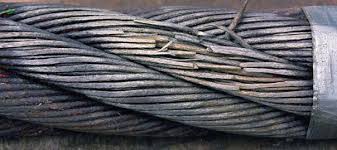
Cable damage

wire rope damage
If your cable looks like any of these, it’s time to replace them.
Warning – it is possible to have broken strands inside a cable without any exterior signs of damage. This situation is especially true on stainless steel cables which do not rust.
Read this article to learn how to lubricate cables. Lubrication slows down premature corrosion. It’s simple and easy to do.
What is the proper lift cable maintenance?
Cable replacement requires a visual inspection of the lift cables. It’s best to inspect it while it is on dry land to check the critical points. Ideally, the lifting platform (or rack) should be in the lowered position. Of course, make sure the lift cable is not allowed to go slack.
Examine the vertical length of the cable for frayed wires, especially near the winch. Excessive fraying or corrosion near the winch is a top signal of damage.
CAUTION – Always wear leather gloves when sliding your hands along the cable. A frayed wire can cause painful damage to unprotected hands.
There are two types of cable wear:
- Internal cable abrasion- Occurs whenever strands work against each other under load.
- External abrasion – Occurs when the cable bends around the winch drum or against the side of the drum.
Every time the boat is raised or lowered, there is internal wear on the cable. Each strand of wire in the winding is moving at a slightly different speed. Abrasion of the cable strands is the result. When the strands break, they lose strength.
Assuming the cable is well cared for, how long should it last?
Experts say that to be safe- replace a galvanized cable every two years. All things being equal, the stainless cable will last longer. Up to 2X as long.
A point often overlooked – internal abrasion and rust are hidden, and there may be no visible damage. A boat lift cable like this will fail without prior warning.
When in doubt, plan on replacing the cables. Trying to squeeze another year out of a $75 cable isn’t worth the risk of dropping your boat or personal injury.
PWS handles Shoremaster cables and can provide new cables for all brands.
Nothing lasts forever – even boat lift cables.
Don’t Forget – Considering rip-rap for your shoreline? PWS is the place to contact!
Where is Pier & Waterfront Solutions?
Located at 7325 St. Hwy 57, it’s 3 miles south of Sturgeon Bay, and 1 mile past the intersection of Cty MM (heading north). Look on the right side, one mile north, at the next intersection (Idlewild Road and Hwy 57).
ARE WE OPEN?
During this time of uncertainty, Pier & Waterfront Solutions is staying “open.” We have implemented measures to ensure the safety of our employees and visitors. At the same time, we are working to maintain the trusted service that you have come to expect.
We are implementing these precautionary measures:
1. Conducting as much business as possible by email, text, or phone.
2. Site visits will continue but with limited in-person meetings. When in-person contacts are necessary, we will follow “social distancing” guidelines.
3. Our display yard is always open for you to examine at your leisure. All displays have a numbered, red tag on them. If you want more information or pricing, please reference that number.
Is there More?
4. Some employees will be working remotely, but they are always available by phone.
5. Any employee with symptoms or illness is sent home.
6. We continue to provide estimates and invoices by email to make the process paperless.
7. Crew starting times are being staggered to limit social interactions.
8. We keep the same crews together to limit cross interactions.
With these measures, we hope everyone will stay safe, and we will be back to normal operations soon.
What can you do to help us?
1. Please conduct as much business as possible via emails, messaging, and emails. This step protects everyone involved.
2. When you see our crews installing equipment, please practice “social distancing.”
Thank you for allowing us to work with you.
So – YES – ARE WE OPEN?
Please call, message, or email us with any questions.
Let’s all stay safe!
Contact:
Jerry @ (920) 493-4404 or Jerry@wisconsinpws.com – Commercial work & new/used Sales.
Dave @ (920) 905-2588 or Dave@wisconsinpws.com – Erosion control & shoreline work.
John @ (920) 493-4405 or John@wisconsinpws.com – Scheduling & Service work
May 12, 2020
USED BOAT LIFT BUYING GUIDE
This Used Boat Lift Buying Guide covers everything you need to know about buying a used boat lift. Avoid added costs. This two-part series will guide you through everything you need to know and what to look for.
There are four main areas to investigate – the frames, the pulley system, and the cables. This article will cover:
- Framework,
- Pulley system,
- Motor setup (if equipped), and
- Rated boat lift capacity vs. your boat weight.
We discuss four more items in Part 2 later this week.
Here’s a list of things to check:
- Are the frames sturdy?
- Do the pulleys have signs of wear or damage?
- Does the motor (if any) operate properly?
- Is the lift appropriately sized for the boat?
ARE THE FRAMES STURDY?
With the lift sitting firmly on the ground, push the upright posts sideways. All frames will move somewhat. If the movement seems excessive, check the bottom diagonal braces near the lower frame carefully. If the structure continues to move after you release it, check all the connections at the bottom thoroughly.
Is the frame moving where the upright posts attach to the bottom frame? If the answer is yes, examine the brace connections and all bolt to see if the bolts are loose or are the holes elongated.
If the drilled holes become elongated, this is a problem. You may have to drill a slightly larger hole and use a different bolt diameter to firm up the connection. NOTE: NEVER DRILL INTO THE LIFT RACK!
If one end of the brace has a slot, make sure the bolt is tight.
Are ALL The bolts tight where the frames connect?
Do the pulleys have visible signs of wear or damage?
The pulley location is in each corner of the boat lift “rack.” The rack is the part of the lift that moves up and down with your boat on it.
Some corners will have one pulley, and others will have two pulleys. If it’s a Shoremaster boat lift, there will never be a problem with broken pulleys. You will never have to replace a brass pulley.
Most brands use hard, black plastic for the pulley. Despite using UV inhibitors in the pulley material, the plastic tends to become brittle with time. When the pulley breaks, it usually involves a part of one side of the pulley groove breaking off.
With one side broken out, the cable jumps out of the groove. When this happens, the rack, especially with the weight of the boat on it, will become VERY difficult to move.
In a single pulley location, the cable drops down onto a bolt and drags across the surface of the bolt. Over time the lift cable will break, or the bolt will wear through and snap.
To check for this condition observe the pulleys at each corner as the rack moves up and down. Check to see if a flange has broken off around the perimeter of each pulley. A broken pulley can be an expensive repair.
Is the cable dragging across a bolt? Are any pulleys frozen in place?
Is there debris (seaweed, reeds, or sand) packed around the pulleys? Remove all the waste to free the cables and pulleys. Even sand can pack so tightly in the tubes that the pulleys will not turn.
DOES THE MOTOR OPERATE CORRECTLY? (If equipped)
With two basic configurations, boat lift motors will save you from sore muscles. Even a child can raise your boat with a boat lift motor. Both types of motor operate by solar energy or electricity. We highly recommend the solar (D.C.) operated models for obvious reasons.
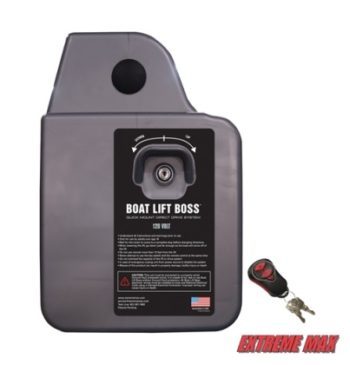
Lift Boss Motor
The best and most dependable type is the Lift Boss brand by Extreme Max. Lift motors come in various shapes, but the Lift Boss has a protective housing around it. The large wheel comes off the lift.
There are three ways to operate the motor – turn-key, pendent, or wireless remote control. You can’t beat the convenience of the wireless remote. Would you physically open your garage door each time? Remember, a boat weighs a lot more than a garage door.
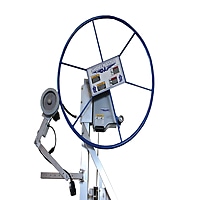
Lift Mate by Shoremaster
The second version is a friction wheel type. You lease the large lift wheel in place and mount the motor to the lift upright. It operates by friction against the larger wheel.
There are two problems with this type. The rubber wheel can become smooth and hard, requiring replacement. A hard or smooth wheel reduces the amount of friction developed by the wheel, causing it to slip.
The second problem is when there is dew on the wheel in the early morning hours or after a rain. Moisture between the two wheels reduces the friction needed to operate. The small wheel slips and will not turn the larger wheel.
DOES THE USED BOAT LIFT HAVE THE CAPACITY FOR YOUR BOAT?
That’s simple, isn’t it? After all, the manual says the boat weighs 2,000# and is 95″ wide.
But does it weigh 2,000#? The best thing you can do is read this article. You will be amazed by what a typical 2,000# boat could weigh when placed on a boat lift.
These are the first four things to check. Later this week, we will explain number 5 through 9.
Tell Your Friends & Family
Have friends or neighbors you believe should see this article? Email them this link for the Used boat lift buying guide – and Thank you!
Also, visit Pier & Waterfront Solutions on Facebook.
Don’t Forget – Considering rip-rap for your shoreline? PWS is the place to contact!
Where is Pier & Waterfront Solutions?
Located at 7325 St. Hwy 57, it’s 3 miles south of Sturgeon Bay, and 1 mile past the intersection of Cty MM (heading north). Look on the right side, one mile north, at the next intersection (Idlewild Road and Hwy 57).
ARE WE OPEN?
During this time of uncertainty, Pier & Waterfront Solutions is staying “open.” We have implemented measures to ensure the safety of our employees and visitors. At the same time, we are working to maintain the trusted service that you have come to expect.
We are implementing these precautionary measures:
- Conducting as much business as possible by email, text, or phone.
- Site visits will continue but with limited in-person meetings.
- When in-person contacts are necessary, we will follow “social distancing” guidelines.
- Our display yard is always open for you to examine at your leisure. All displays have a numbered, red tag on them. If you want more information or pricing, please reference that number.
Is there More?
- Some employees will be working remotely, but they are always available by phone.
- Any employee with symptoms or illness is sent home.
- We continue to provide estimates and invoices by email to make the process paperless.
- Crew starting times are being staggered to limit social interactions.
- We keep the same crews together to limit cross interactions.
With these measures, we hope everyone will stay safe, and we will be back to normal operations soon.
What can YOU do to help us?
- Please conduct as much business as possible via emails, messaging, and emails. This step protects everyone involved.
- When you see our crews installing equipment, please practice “social distancing.”
Thank you for allowing us to work with you.
So – YES – WE ARE OPEN!
Please call, message, or email us with any questions.
Let’s all stay safe!
Contact:
Jerry @ (920) 493-4404 or Jerry@wisconsinpws.com – Commercial work & new/used Sales.
Dave @ (920) 905-2588 or Dave@wisconsinpws.com – Erosion control & shoreline work.
John @ (920) 493-4405 or John@wisconsinpws.com – Scheduling & Service work



